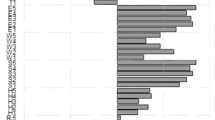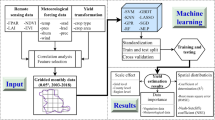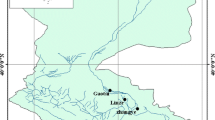Abstract
Climate factors have distinct impacts on crop yields. Understanding the relative importance of these factors to crop yield variation could provide valuable information about crop planting and management under climate change condition for policymakers and farmers. The current study investigated the applicability of support vector machines (SVMs) in determining the relative importance of climate factors (mean temperature, rainfall, relative humidity, sunshine hours, daily temperature range, and rainy days) to yield variation of paddy rice in southwestern China. The SVM models were compared with traditional artificial neural networks and multiple linear regression. The performance accuracy was evaluated by mean absolute error (MAE), mean relative absolute error (MRAE), root mean square error (RMSE), relative root mean square error (RRMSE), and coefficient of determination (R 2). Comparative results showed that SVMs outperformed artificial neural networks and multiple linear regression. The SVM with radial basis function performed best with MAE of 0.06 t ha−1, MRAE of 0.9 %, RMSE of 0.15 t ha−1, RRMSE of 2.23 %, and R 2 of 0.94. The results showed that SVMs are suitable for determining the effects of climate on crop yield variability. The relative importance of the studied climate factors to rice yield variation was in order of sunshine hours > daily temperature range > rainfall > relative humidity > mean temperature > rainy days in the current study area.




Similar content being viewed by others
References
Basak D, Pal S, Patranabis DC (2007) Support vector regression. Neural Info Proc 11:203–224
Chen JL, Liu HB, Wu W, Xie DT (2011) Estimation of monthly solar radiation from measured temperatures using support vector machines—a case study. Renew Energy 36:413–420
Dobermann A, Dawe D, Roetter RP, Cassman KG (2000) Reversal of rice yield decline in a long-term continuous cropping experiment. Agron J 92:633–643
Evans LT (1993) Crop evolution, adaptation and yield. Cambridge University Press, Cambridge
Flake GW, Steve L (2002) Efficient SVM regression training with SMO. Mach Learn 46:271–290
Jain AK, Mao J, Mohiuddin KM (1996) Artificial neural networks: a tutorial. Computer 29(3):31–44
Jalota SK, Singh S, Chahal GBS, Ray SS, Panigraphy S (2010) Soil texture, climate and management effects on plant growth, grain yield and water use by rainfed maize-wheat cropping system: field and simulation study. Agric. Water Manag 97:83–90
Kanungo DP, Arora MK, Sarkar S, Gupta RP (2006) A comparative study of conventional, ANN black box, fuzzy and combined neural and fuzzy weighting procedures for landslide susceptibility zonation in Darjeeling Himalayas. Eng Geol 85:347–366
Li YH, Xu HM, Liu D (2009) Features of the extremely severe drought in the east of southwest China and anomalies of atmospheric circulation in summer 2006. Acta Meteorol Sin 67(1):122–132
Li YJ, Ren FM, Li YP, Wang PL, Yan HM (2014) A study of the characteristics of the southwestern China regional meteorological drought events during 1960–2010. Acta Meteorol Sin 72(2):266–276
Liu HB, Gou Y, Wang HY, Li HM, Wu W (2014) Temporal changes in climatic variables and their impact on crop yields in southwestern China. Int J Biometeorol 58:1021–1030
Lobell DB (2007) Changes in diurnal temperature range and national cereal yields. Agric For Meteorol 145:229–238
Lobell DB, Field CB (2007) Global scale climate-crop yield relation-ships and the impacts of recent warming. Environ Res Lett 2:1–7
Lobell DB, Cahill KN, Field CB (2007) Historical effects of temperature and precipitation on California crop yields. Clim Chang 81:187–203
Marquardt DW (1963) An algorithm for least-squares estimation of non-linear parameters. J Soc Ind Appl Math 11:431–441
Mathe-Gaspar G, Fodor N, Pokovai K, Kovacs GJ (2005) Crop modeling as a tool to separate the influence of the soil and weather on crop yields. Phys Chem Earth 30:165–169
Peltonen-Sainio P, Jauhiainen L, Trnka M, et al. (2010) Coincidence of variation in yield and climate in Europe. Agric Ecosyst Environ 139:483–489
Peng S, Huang J, Sheehy JE, Laza RC, Visperas RM, Zhong X, Centeno GS, Khush GS, Cassman KG (2004) Rice yields decline with higher night temperature from global warming. Proc Natl Acad Sci 101:9971–9975
Schölkopf B, Smola A (2002) Learning with kernels. MIT, Cambridge
Szuster BW, Chen Q, Borger M (2011) A comparison of classification techniques to support land cover and land use analysis in tropical coastal zones. Appl Geogr 31:525–532
Tao FL, Yokozawa M, Xu YL, Hayashi Y, Zhang Z (2006) Climate changes and trends in phenology and yields of field crops in China, 1981–2000. Agric For Meteorol 138:82–92
Vapnik VN (1995) The nature of statistical learning theory. Springer, New York
Vapnik VN (1998) Statistical learning theory. Adaptive and learning systems for signal processing, communications, and control. Wiley, New York
Vapnik VN, Golowich S, Smola AJ (1997) Support vector method for function approximation, regression estimation and signal processing. Advances in Neural Information Processing Systems 9. MIT Press, Cambridge
Wu W, Liu HB (2012) Assessment of monthly solar radiation estimates using support vector machines and air temperatures. Int J Climatol 32:274–285
Yang W, Peng S, Laza RC, Visperas RM, Dionisio-Sese ML (2008) Yield gap analysis between dry and wet season rice crop growth under high-yielding management conditions. Agron J 100:1390–1395
Yoon H, Jun SC, Hyun Y, Bae GO, Lee KK (2011) A comparative study of artificial neural networks and support vector machines for predicting groundwater levels in a coastal aquifer. J Hydrol 396:128–138
Zhang TY, Zhu J, Wassmann R (2010) Responses of rice yields to recent climate change in China: an empirical assessment based on long-term observations at different spatial scales (1981–2005). Agric For Meteorol 150:1128–1137
Acknowledgments
The authors thank the National Climate Center, China Meteorological Administration (CMA), for providing the meteorological data.
Author information
Authors and Affiliations
Corresponding author
Rights and permissions
About this article
Cite this article
Chen, H., Wu, W. & Liu, HB. Assessing the relative importance of climate variables to rice yield variation using support vector machines. Theor Appl Climatol 126, 105–111 (2016). https://doi.org/10.1007/s00704-015-1559-y
Received:
Accepted:
Published:
Issue Date:
DOI: https://doi.org/10.1007/s00704-015-1559-y




